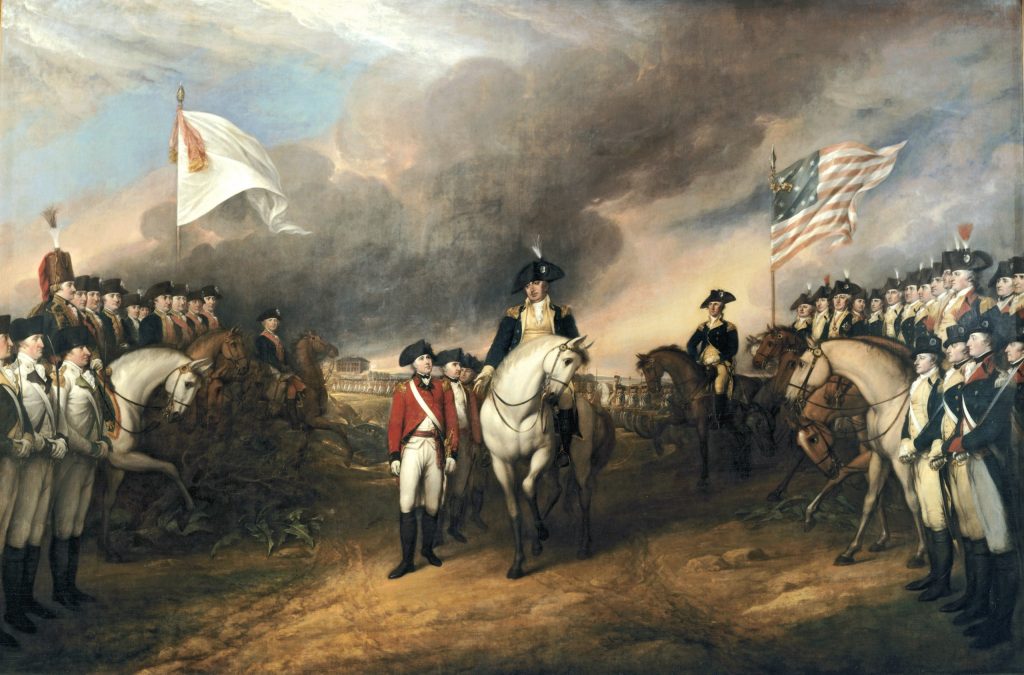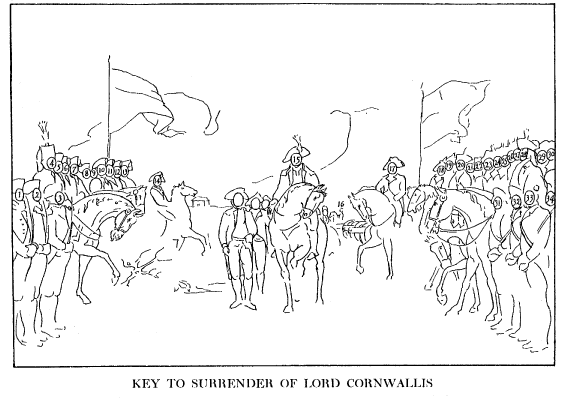
Jump to key figures in this painting.
The first impression most people get when they view this work is that the white flag on the viewer’s left is a flag of surrender, and therefore, the soldiers on the left are British. Wrong. As you know if you’ve gone through our “Flags Over America” exhibition, the white flag is the symbol of the House of Bourbon, the royal family of France. Hence, the soldiers to the left are French, the British are the ones on foot in the center.
The inspiration for the work, in Trumbull’s own words:
“The success of this officer in the southern states, during the years 1780 and 1781, the capture of Charleston, the victory of Camden, and various minor successes, by which almost every part of Georgia and South and North Carolina had been successively occupied by the British troops, had seriously threatened the ruin of American independence.
In 1781, Lord Cornwallis… marched with the principal part of his force into Virginia, where, for some time, his success was almost equally rapid and complete; but the admirable combined movement of General Washington and our French allies, from the north, and of the Count de Grasse, with the fleet and army of France, from the West Indies, turned the scale, and rendered it necessary for him to shut himself up in Yorktown, and attempt to defend himself there, until he could receive relief from New York. This hope, however, failed him, and on the 19th of October, he surrendered his forces to the combined armies of America and France.
The American troops were drawn up on the right of the road leading into York; General Washington and the American general officers on the right. The French troops on the opposite side of the Road facing them; General Rochambeau and the principal officers of the French army and navy on the left….
The painting represents the moment when the principal officers of the British army, conducted by General Lincoln, are passing the two groups of American and French generals, and entering between the two lines of the victors; by this means the principal officers of the three nations are brought near together, so as to admit of distinct portraits.
In the centre of the painting, in the distance, is seen the entrance of the town, with the captured troops marching out, following their officers, and also a distant glimpse of York River, and the entrance of the Chesapeake Bay, as seen from the spot.”
Trumbull tells us that upon his return from Paris to London in 1786 he began the composition of other historical paintings, among which were: “The Battle of Trenton,” “The Battle of Princeton” and “I also made various studies for the Surrender of Lord Comwallis, and in this found great difficulty; the scene was altogether one of utter formality – the ground was level – military etiquette was to be scrupulously observed, and yet the portraits of the principal officers of three proud nations must be preserved, without intercepting the general regularity of the scene. I drew it over and over again, and at last, having resolved upon the present arrangement I prepared the small picture to receive the portraits.”
We know that Trumbull painted the portraits of the French officers into this canvas while a guest in Jefferson’s house in the Grille de Chaillot, Paris, in September of 1787 (On October 20, 1823, Trumbull wrote Lafayette: “The surrender of Cornwallis, in which are portraits of yourself and the principal French officers who were present on that great occasion [are] copied from the small picture which you saw me engaged upon in Paris in 1787.”), that he painted in the portrait of Washington while in New York in February or March, 1790, and those of most of the other American officers before 1794.
We know also that Trumbull visited Yorktown to sketch the very scene of the surrender, as a sketch survived endorsed as follows: “Yorktown, in Virginia, April 23, 1791, as seen from the point the British army entered between the lines of the Allied Troops of America and France at the surrender in ’81; distance from the advanced works, 270 yards.” The large building with its surrounding earthworks below and to the right of DeGrasse’s horse and “the distant glimpse of the York River and the entrance of Chesapeake Bay” in the finished composition, appear in this sketch.
This painting offers another interesting glimpse of history versus art. One of the criticisms of the work was that it introduced Lord Cornwallis in the scene of the surrender; and when that gross violation of known fact was objected to, Trumbull gave the figure another name, and in his catalogue says, generally, “the principal officers of the British army.”
To understand what Trumbull probably did, the facts of the surrender must be examined. Washington Irving, quoting an eyewitness of the scene, says: “The British were led by General O’Hara on horseback, who riding up to General Washington, took off his hat and apologized for the nonappearance of Lord Cornwallis, on account of indisposition. Washington received him with dignified courtesy, but pointed to Major-General Lincoln as the officer who was to receive the submission of the garrison. By him they were conducted into a field where they were to ground their arms.” In the published key, the central figure on horseback (No. 15) is called General Lincoln, but a comparison of the known portraits of Lincoln and Cornwallis leaves little doubt but that the figure originally represented Cornwallis.
It is entirely possible that portraits of Cornwallis were available to Trumbull in London in 1786, and those of O’Hara were not, and this fact also had its weight. Cornwallis was painted bv many of the leading artists of his day, and upwards of twenty prints of such portraits would have been available to Trumbull before he left England in 1789. Examination of the engraved portraits of General Lincoln and Lord Cornwallis show that Lincoln was a large, heavy man and not unlike Cornwallis in general appearance, but figure No. 15 resembles the engraving by Francis Hayward, R.A., of the portrait of Cornwallis by Daniel Gardner, published February 24, 1784.
A manuscript of Trumbull that was once in the possession of the American Academy of Fine Arts states that: “The head of General Lincoln, at the Surrender of York Town was painted in Boston…” It is difficult to determine at this late date just what was done or when the head of General Lincoln was put into the canvas (if it is Lincoln), but one deduction would seem clear: when the portrait of Cornwallis in the scene of the surrender was criticized by the public, the change was made.
It is also worth noting that of the 250 portraits by Trumbull in the group of historical paintings at Yale, only the likeness of General Lincoln has been questioned.
Key figures in this painting
- Count Deuxponts, Colonel of French Infantry
- Duke de Laval Montmorency, Colonel of French Infantry
- Count Custine, Colonel of French Infantry
- Duke de Lauzun, Colonel of French Cavalry
- General Choizy
- Viscount Viomenil
- Marquis de St. Simon
- Count Fersen, Aide-de-Camp of Count Rochambeau
- Count Charles Damas Aide-de-Camp of Count Rochambeau
- Marquis Chastellux
- Baron Viomenil
- Count de Barras, Admiral
- Count de Grasse, Admiral.
- Count Rochambeau, General in chief of the French
- General Lincoln
- Colonel Ebenezer Stevens, American Artillery
- General Washington, Commander in Chief.
- Thomas Nelson, Governor of Virginia.
- Marquis de Lafayette.
- Baron von Steuben.
- Colonel Cobb, Aide-de-Camp to General Washington.
- Colonel Trumbull
- Maj. Gen. James Clinton
- General Gist, Maryland.
- General Anthony Wayne
- General Hand, Adjutant General, Pennsylvania
- Gen. Peter Muhlenberg
- Major General Henry Knox
- Lt. Col. E. Huntington, Aide-de-Camp of General Lincoln.
- Col. Timothy Pickering
- Colonel Alexander Hamilton
- Colonel John Laurens
- Col. Walter Stuart, Philadelphia
- Col. Nicholas Fish, New York


